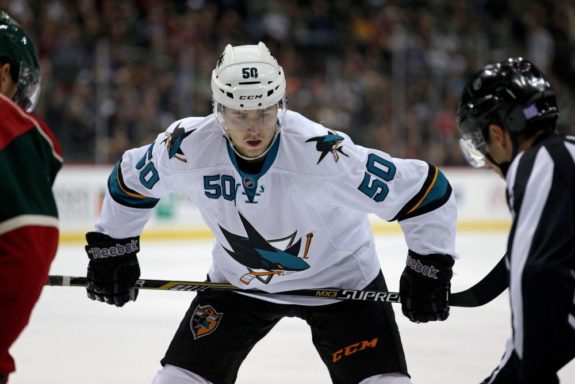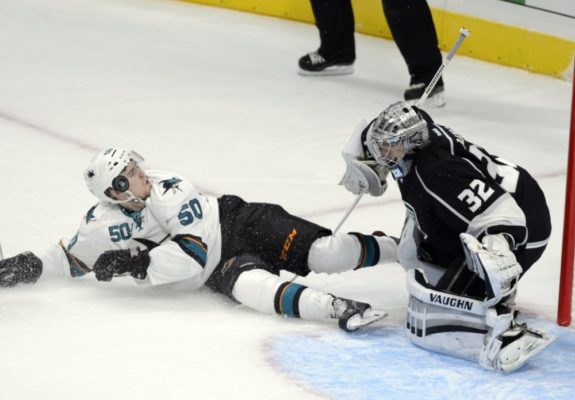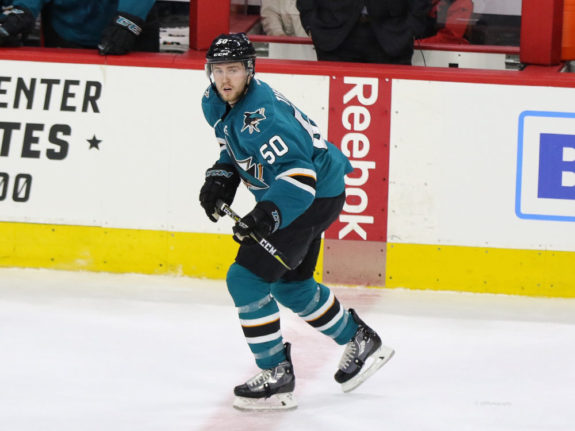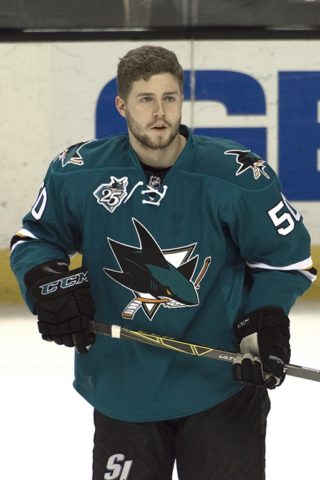San Jose Sharks center and restricted free agent Chris Tierney agreed to the terms of his qualifying offer from the team this week, and it’s pretty puzzling at first glance. A one-year deal for $735,000 seems low for a three-year pro coming off of his best season by several different measures. There are a number of reasons this deal makes sense for the team and for the player, but what does it mean? What does it all mean?!
Past Performance…
Tierney had a monster year in 2016-17. The man they call the Cobra scored 11 goals and 23 points while averaging 14:36 time on ice and winning 48.5 percent of his faceoffs through 80 games played, all career highs. Tierney’s 0.29 points per game were a significant drop from the 0.49 of his rookie year, but his on-ice shooting percentage that year was a team-high 8.97 percent, suggesting a preponderance of puck luck for those 43 games.
Tierney’s 11 goals in 2016-17 were sorely needed, tying him for fifth in goals on a team that struggled to generate depth goal-scoring. His scoring could be timely as well, as Tierney put up two goals and seven points in 14 games in November, a month in which San Jose struggled to generate offense, ranking 20th in goals scored during the month. While the Sharks limped into the postseason, nursing serious injuries to Joe Thornton and Logan Couture among others, Chris Tierney picked up the slack, scoring six points in his final 13 games of the season, good for fourth on the sinking Sharks.

Tierney’s possession numbers improved in his third season as well. The center’s on-ice Corsi-for percentage at 5-on-5 was 49.97, and his relative Corsi for percentage came in at -1.50. Not jump-off-the-page impressive figures in a league full of Bergerons and Doughtys to be sure, but Tierney fought against the current for much of the year in terms of usage. Tierney started a lower percentage of his shifts in the offensive zone (27.69 percent) than any Sharks forward, and lower than any Sharks skater not named Marc-Edouard Vlasic or Justin Braun. He also ranked below goaltenders Martin Jones and Aaron Dell in this stat, but that is silly.
Predicting Tierney’s Future Performance
The team and its fans and analysts have longed for Tierney to grow into the role of third-line center for years, and apart from occasional streaks of brilliance, he has struggled in that role. From a team perspective, this could be a “prove-it” deal, allowing Tierney the opportunity to show general manager Doug Wilson and company that these incremental improvements are but a taste of what’s to come, and that he can be the 3C the team has been looking for.
There are two scenarios in 2017-18 that could necessitate that kind of evolution out of Tierney, one much more painful than the other.

Okay, let’s rip the band-aid off. Joe Thornton played with two torn cruciate ligaments in his right knee through four playoff games this past spring, and while his dominance on the ice was only partially suppressed in such a small sample, those kinds of injuries have a tendency to haunt a player for years, if not entire careers. If Thornton’s injury is even a little bit more serious than he lets on, he may need to rest more often than he has in the past, and every center on the team will get a bump up the depth chart. We may even see this as the season starts if Thornton is unable to meet the aggressive recovery schedule set for him.
The other instance that may see Tierney’s responsibilities increase is that of Tomas Hertl, Power Winger. It would not be the first time the Sharks’ coaching staff has called on the Czech to vary his role, as Hertl spent a good portion of the 2016-17 season on Thornton’s wing across from Joe Pavelski, and Tierney predictably moved up the lineup. Whether the fourth line would be centered in that situation by the newly re-signed Ryan Carpenter or the emergent Danny O’Regan remains to be seen.
If Chris Tierney Is So Great…
Why is he only getting a one-year deal, and why is it only worth $735,000? Tierney seems to project well for the Sharks as a centerpiece (haha) down the middle for the future, so why was he only signed for one year, and at such a low salary? If you are easily bored by cap talk, go ahead and scroll down to the comments, because here there be monsters.

According to the CBA, if a restricted free agent signed his entry-level contract (ELC) between ages 18 and 20, he is not eligible to file for arbitration until after his fourth professional season. Tierney signed his ELC with the Sharks at age 19 in 2013 after playing three full seasons with the OHL’s London Knights, where he placed fifth on the junior team in regular season points.
Perhaps the push for a one-year deal came from the player’s camp in this case so that he would have more leverage after 2017-18 to push for an AAV closer to his actual worth. Without the threat of arbitration, Tierney’s camp had no leverage with which to negotiate with Wilson and the Sharks this offseason, so it behooves him to sign the minimum qualifying offer levied by the team and prove his worth.

From a team perspective, this kind of deal provides minimal risk; if Tierney continues to improve, he’ll earn his pay one year later, giving the Sharks a year to contend while paying Joe Thornton $8 million and providing the flexibility in 2017-18 to re-sign restricted free agents Marcus Sorensen and Barclay Goodrow (both of whom declined to file for arbitration, despite being eligible), as well as in 2018-19 to fit Tierney’s next deal in with the recently-signed extensions to Vlasic and Jones.
It wouldn’t be the first time this kind of contract hedging has benefited the team in recent memory, either, if the name Matt Nieto rings any bells. Nieto accepted an identical one-year, $735,000 deal in his age-23 season, and, due to a subsequent drop in production, was waived and claimed by the Colorado Avalanche.
Tierney’s new contract can be misleading when compared to his previous deal. The new contract is one-way, the first of Tierney’s career, meaning he receives the same salary in case he is assigned to the AHL. Additionally, the salary of Tierney’s new contract is actually higher than his previous one but carries a lower AAV due to the differing bonus structure of the two contracts.
Tierney’s new contract may seem confusing at first glance, but if he continues to develop as the team seems to believe he will, the Sharks’ appreciation for what he brings to the ice will certainly start showing up on his paycheck.
Just not yet.